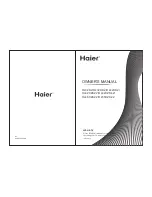
103
ENGLISH
Router
A router is a network component that links sev-
eral computer networks. The router analyses (on
the basis of layer 3 information) the network
packages of a protocol it receives and forwards
it to the intended destination network. Conven-
tional routers work on layer 3 of the application
layer. A router has an interface for every net-
work connected to it. When data is received, the
router determines the correct path to the destina-
tion and thereby the suitable interface via which
the data can be transferred. For this it uses a
locally available routing table that specifies via
which router connection a particular network
can be reached.
RoviGuide™
Electronic channel guide with various informa-
tion on the television programmes.
SCR(SingleChannelRouter)
Unrestricted single cable system.
If your antenna system is equipped with a single
cable multi-switch, the televisions which are con-
nected to this antenna system can receive televi-
sion channels independently from one another.
Security(WEP/WPA)
WEP (wired equivalent privacy) is the standard
encryption algorithm for WLAN. It controls both
access to the network as well as ensuring the
confidentiality and integrity of data. This proce-
dure is considered insecure nowadays. For this
reason, more recent WLAN installations should
use the more secure WPA encryption.
Symbolrate
This is the number of transmitted symbols in the
digital transmission technology per time unit
Transponder
A transponder receives data on a satellite and
then transmits it again. For example, an earth
station can transmit data signals for television
channels to a geostationary satellite, which
sends this back to earth. Any suitable satellite
antenna with visual contact to the satellite can
receive the signal.
VibrantColour
Increases the colour contrast and the contrast
adjustment. This setting is mostly too strong for
use with normal pictures and should only be
used where necessary (low or off) otherwise
nuances in the image can be suppressed.
Wi-Fi
The Wi-Fi Alliance is an organisation that has
taken on the task of certifying products from
different manufacturers on the basis of the IEEE-
802.11 standard, thereby ensuring that different
wireless devices can operate in parallel.
On 31 October 2002, the consortium an-
nounced a new encryption technology – Wi-Fi
Protected Access (WPA) – a part of the (then)
forthcoming IEEE standard 802.11i which would
replace the WEP encryption procedure, which
was already regarded as insecure before the
new standard came into force. After 802.11i
came into force, the Wi-Fi group coined the term
WPA2.
IEEE 802.11e is an industrial standard issued
by the Institute of Electrical and Electronics En-
gineers (IEEE) and a supplement to the wireless
LAN standard IEEE 802.11 for supporting the
quality of service.
802.11e works according to a similar principle
as the QoS procedure DiffServ. Data packages
in the WLAN are marked by the sender and the
access point is stopped in order to handle pack-
ages with higher priority.
With the aid of 802.11e, real-time application
such as Voice over IP are better supported as
they require a certain bandwidth in the network
to ensure the connection is not interrupted if
other network traffic creates too great a burden
on the available data transfer rate.
GLOSSARY
--------------------------------------------------------------------------------------------------------------
Содержание 43 GFW 6820
Страница 1: ...EN 43 GFW 6820...
Страница 108: ...Grundig Intermedia GmbH Thomas Edison Platz 3 D 63263 Neu Isenburg...






































